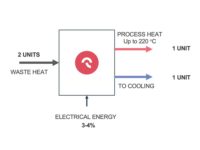Last month, I wrote about how many of the high-profile regional bank failures were due to conditions uncommon to most institutions. However, there is one major issue facing banks of all types and size — office buildings vacancies.
Property owners need to find a way to fill these buildings, and this creates an opportunity for the HVAC industry. That’s because one way to get occupants is by turning office buildings into residential buildings.
The COVID-19 pandemic caused a major shift in the way people worked. Telecommuting on a large scale always seemed like an idea five years in the future. Then businesses and employees faced no choice but to embrace the concept. As is often the case, once forced to change, people embraced it, and now show little interest in returning to the old way of doing things.
The number of employees returning to the office has peaked at about 50% of the pre-pandemic total. There are some companies that talk about ordering more employees back to the office, such as Facebook’s recent announcement that workers must spend at least three days a week in the office starting in September.
Still, most companies are happy to avoid paying rent and the other expenses that come with operating an office. And employees are happy to take on some of the costs if it means not having to commute.
This is starting to mean a lot of vacant buildings, ranging from skyscrapers to strip malls. That creates an unhappy situation for many parties — office building owners, the banks that finance them, the cities where these buildings are located, and the service providers that depend on office workers nearby.
This is where turning offices into residential properties comes into play. Such a project is slated for the town in which I live. A 103,000-square-foot office building will turn into 250 residential units. Obviously, this transformation requires an extensive overhaul of the HVAC system.
How many projects like this will arise in the coming years? There is plenty of potential, but many factors have to line up to meet that potential. First, these projects need to attract residents. Empty apartment buildings are no better than empty office buildings. Second, they need willing owners who see the value in making the large investment to repurpose these properties. Some may still hold on to the belief that workers will eventually return. That’s unlikely. Finally, city officials need to show flexibility when it comes to zoning, creating more mixed-use space than already exists in most cases.
The opportunity is there. In addition to apartments, empty office space can turn into everything from warehouses to indoor agriculture facilities. All these have HVAC requirements that are greatly different from what currently exists in these structures. The next decade could bring a golden age of retrofit work for the HVAC industry. Engineers need to prepare for how they will execute these projects when they arise.
This is good news. A major issue today could turn into a major opportunity tomorrow. As the old saying goes, “Even a broken window provides work for the glazier.”





